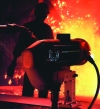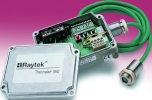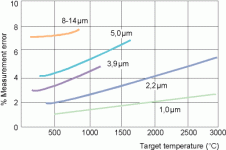

After time, temperature is the second most measured physical unit. In production as well as in quality control and maintenance, temperature represents an important indicator of product quality or equipment conditions.
The advantages of infrared thermometers
* Fast response time (ms range), user gets more information per time period.
* Measure objects that move, rotate or vibrate (eg, web processes or any moving process).
* Measure high temperatures (above 1500°C). Contact probes will not work or have a short lifetime.
* No mechanical damage or contamination of the surface (painted surfaces, food, soft plastic).
* No influence of objects with high thermal-conductivity where object temperature would change if contacted (eg, glass, wood, small or very thin objects).
* Measure actual product being manufactured instead of another part of the process.
Considerations when using infrared thermometers
* The ability to view the object by direct line-of-sight (closed chambers do not allow measurement if a window is not available).
* The optics of infrared thermometers need to be protected against dust or condensation (manufacturers offer a variety of accessories).
* In general, IR thermometers measure only surface temperatures and the ability to emit thermal radiation depends on the kind of material and especially on the surface finish.
IR thermometers
During the last three years the IR sensor market has seen two major trends.
* First, IR thermometers are significantly lower in cost. The most expensive parts of an infrared thermometer are the lenses and detectors. New lens materials and technologies (plastic, fresnel lenses) and mass production of IR detectors for consumer products such as toasters, hair dryers and ear-thermometers, have resulted in lower prices for these two important components. Together, with the increased demand for industrial IR thermometers, high volume production of standard sensors has resulted in greater manufacturing efficiency for the IR thermometer manufacturers. Some types of IR sensors are down 50% in cost from five years ago.
* Second, IR sensors are becoming smaller in size. In the past, the measurement of low temperatures made it necessary to use fast (low F number) lenses with relatively large diameters in order to capture enough emitted energy. Progress in detector technology and the use of micro system techniques (better detector performance) together with improved low noise analog preamplifier techniques have helped reduce the dimensions of the IR-sensing head dramatically. Because the newer sensors have greater response characteristics they require less energy to achieve a usable signal. As a result, lenses can have smaller diameters. Figure 1 shows an example of such a miniature IR sensor. The diameter of the lens is only a few millimetres but the sensor has an excellent temperature resolution of 0,1°C and can measure down to 0°C.

Applications for such small sensors are in all industries, especially on small machines where space is limited. Until the advent of miniature sensors, there was almost no use of infrared temperature measurement.
Detector and optics - the heart of the IR thermometer
There are two main groups of detectors that you can find in an IR-thermometer - thermal detectors and photoelectric or photon detectors. Thermal detectors must first change their own temperature due to the sensed radiated energy. Similar to a thermocouple, this temperature change produces a certain voltage level that corresponds to a temperature. Photoelectric detectors (eg, photo diodes) react to the incoming photons, which results in an increase of electron/hole pairs and then in an increased current signal. Thermal detectors respond less quickly than the photoelectric detectors because they have to 'feel' a temperature change. The difference in response time is relative, but can make a big difference depending on the application. In the case of thermal detectors 'slow' means time constants in the millisecond range compared to nano- or microseconds for photoelectric detectors. Below is listed an overview of the IR detectors that are commonly used today.

Photoelectric detectors are best suited for applications where speed is important. Thermal detectors are still widely used for low temperature IR thermometers because they are less expensive and a fast response is less important.
New InGaAs detectors
InGaAs (Indium/Gallium/Arsenide) detectors were first used to measure gas concentration and humidity. As with most technologies, there has been a demand to reduce costs, to improve sensor features, and to look for new markets and applications. For instance, the demand for low cost gas concentration and consumer level blood pressure measurement systems created a huge technology push for InGaAs sensors. This demand has benefited both the manufacturers and the medical field, and secondly, the consumer. InGaAs-detectors are now available with wavelengths at 1,6; 1,9; 2,2 and most recently, at 2,6 microns at a reasonable cost. Figure 2 shows the detectivity as a function of wavelength for an InGaAs-detector. They have nearly replaced the traditional Germanium-detectors because they are less expensive to manufacture and more powerful.

What are the advantages of these new detectors?
Looking back to Figure 2, we know that if you choose a lower wavelength IR thermometer and you want to measure at lower temperatures, you get only a small radiation signal. Detectors with better detectivity or sensitivity make it possible to get a larger electrical signal for the same radiation level. A reasonable signal is possible even when there is much lower energy or temperature.
It is best to use the shortest possible wavelength, this is especially true when measuring metal objects because their emissivity is typically higher at shorter wavelengths. Assuming a 10% error in emissivity, Figure 2 shows that the error with a shorter wavelength will be less than that of the error with a longer wavelength. Therefore, it is best to use the sensor with the shortest wavelength for the necessary temperature range.
An object's emissivity is typically higher at lower wavelengths. Therefore, for the lowest percentage error due to emissivity, the user should select the IR thermometer with the lowest possible wavelength in the correct temperature range.
For instance, with an object of 400°C, the error in reading using a 2,2 micron spectral wavelength will be 2% but at the 8 to 14 micron spectral wavelength range, the error will be more than 7%. And there is also another effect to consider. Usually the emissivity changes with the temperature. This dependency is much less at shorter wavelengths and makes the use of infrared measurement much easier. This opens new applications where infrared was much more difficult to use in the past. New applications include secondary metal applications, specifically with non-ferrous metals. For example, in the automotive industry there is a trend to replace traditional steel with nonferrous metals. The result is that manufacturers are able to run their production process (forming, tempering, hardening) at much lower temperatures - and there are IR thermometers that work at these lower temperatures.
These factors are important when choosing the correct infrared thermometer. To measure above 1000°C one would not use a standard unit with 8 to 14 micron wavelength. However there are many units on the market that quote low error on high temperatures - but have the wrong wavelength detector.
Trends in IR-thermometer electronic design
Due to the increasing expectations of the user and competition among manufacturers, infrared thermometers are continually being improved and electronic design is an area that has seen the most improvements recently.
Process industries continue to need sensors with higher accuracy and repeatability as they look for ways to cut costs, maximise their production lines, and monitor quality. Easy installation, use, and maintenance continue to be important, as does the ability to withstand harsh environmental conditions. Field checking and field calibration features are becoming more and more important as companies look to optimise their personnel and equipment resources. And finally, manufacturers need IR sensors with a wide operating temperature range that covers more applications and eliminates the demand for water/air-cooled housing, which keeps the cost down due to less water/air consumption and hardware required.
IR thermometer manufacturers are taking advantage of the many developments in other industries to continue to expand the capabilities and efficiencies of the IR thermometer. These advances have made a variety of products readily available and affordable where even five years ago they were only used for specific military applications because of the high cost.
Advances in detectors and optics of infrared thermometers are helping manufacturers and their customers expand the types of applications where IR can be used effectively, gain speed and accuracy, and get a better return on their investments. Two-colour or ratio measurement and units with built-in visual cameras are just some of the latest advances.
Raytek, a leading supplier in the infrared measurement industry, designs, manufactures, and markets a complete line of online and portable non-contact thermometers and line scanners for industrial, maintenance, and quality control applications.
For more information contact R&C Instrumentation, 086 111 4217, [email protected], www.randci.co.za
| Tel: | +27 11 608 1551 |
| Email: | [email protected] |
| www: | www.randci.co.za |
| Articles: | More information and articles about R&C Instrumentation |

© Technews Publishing (Pty) Ltd | All Rights Reserved